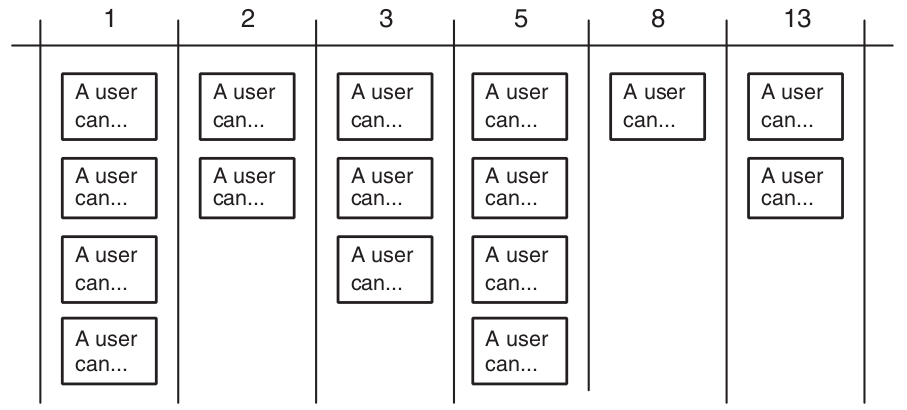User Stories
They do come true!
Overview
What are User Stories?
- Short description of valued functionality.
- Discussion.
Written by the Product Team
- User Stories must be written in the language of the business, not technical jargon.
- As the primary product visionaries, Product is in the best position teo describe the behavior of the product.
User Stories
Independent, Negotiable, Valuable, Estimatable, Small, Testable
Independent
User Stories must be as independent as possible.
Tasks that depend on each other:
- Customers can pay with Visa (3 days)
- Customers can pay with MasterCard (0.5 days)
- Customers can pay with Visa Electron (0.5 days)
Breaking the dependency
- A customer can pay with one type of credit/debit card (3 days)
- A customer can pay with two additional types of credit cards (1 day)
Note: Accept Visa, Visa Electron and MasterCard.
When that's not possible
- Customers can pay with Visa (3 | 0.5 days)
- Customers can pay with MasterCard (3 | 0.5 days)
- Customers can pay with Visa Electron (3 | 0.5 days)
Negotiable
User Stories should be discussed between Product and Engineering/Operations/Architecture.
Valuable to users or the company
Valuable to users:
- All errors are presented to the user and logged consistently.
Not valuable to users:
- All error handling is done through the Logger class.
Estimatable
Engineering must be able to estimate the user stories.
Possible problems:
- Engineering lacks domain knowledge -> Discuss with Produt
- Engineering lacks technical kowledge -> Learn/experiment/build prototype
- The Story is too big -> Product must separate it in smaller stories.
Small
Compound stories
- Merchants can sell products in points of sale.
Split in:
- Merchants can create and edit points of sale.
- Merchant can assign products to points of sale.
- Users accessing a point of sale can buy products assigned to it.
Small
Complex stories
- Users can pay with Direct Debit.
Split in:
- Investigate Direct Debit payments.
- Users can pay with Direct Debit.
How to split
- Workflow steps.
- Business rule variations.
- Major effort (credit card payments).
- Simple/complex: look for simplest version, add complex variations.
- Variations in data.
- Data entry methods (simple vs fancy input).
- Performance.
- Operations (CRUD).
- Break out a spike (investigate, prototype).
Testable
All User Stories should be testable unless not possible.
Responsibilities: Engineering
- Help product write stories.
- When asking for a story abouth the use of technology, describe the need in terms of its value to users or the company.
Responsibilities: Product
- Write user stories that have value, are independent, are testable and appropiately sized.
- Discuss them with Tech.
Acceptance testing
- Write tests upfront
- Test for bugs, not coverage
Engineering <-> Product
- What else do the programmers need to know about this story?
- What am I assuming about how this story will be implemented?
- Are there circumstances when this story may behave differently?
- What can go wrong during the story?
Responsibilities: Engineering
- Automating the execution of acceptance tests.
- Thinking about additional acceptance tests when developing a new story.
- Unit testing the code so that acceptance tests do not need to be specified for every small detail.
Responsibilities: Product
- Writing the acceptance tests.
- Software is written to fulfill a vision held by Product.
- Executing the acceptance tests.
Guidelines for Good Stories
Goal Stories
For each role, identify their goals.
If the stories are too big, split them.
Closed Stories
- Closed stories finishes with the achievement of a meaningful goal.
- Users feel that they have accomplished something.
Constraints
Identify constraints (eg support i18n in the future, reports that process 10ks of records)
Estimating
Triangulation

Responsibilities: Engineering
- Defining story points so that they are relevant and usable by the team team.
- Sticking to that definition.
- Giving honest estimates (avoid temptation or pressure).
- Estimating as a team.
- Giving estimates that are consistent with other estimates.
Responsibilities: Product
- Participating in estimation meetings, but only to answer questions and clarify stories.